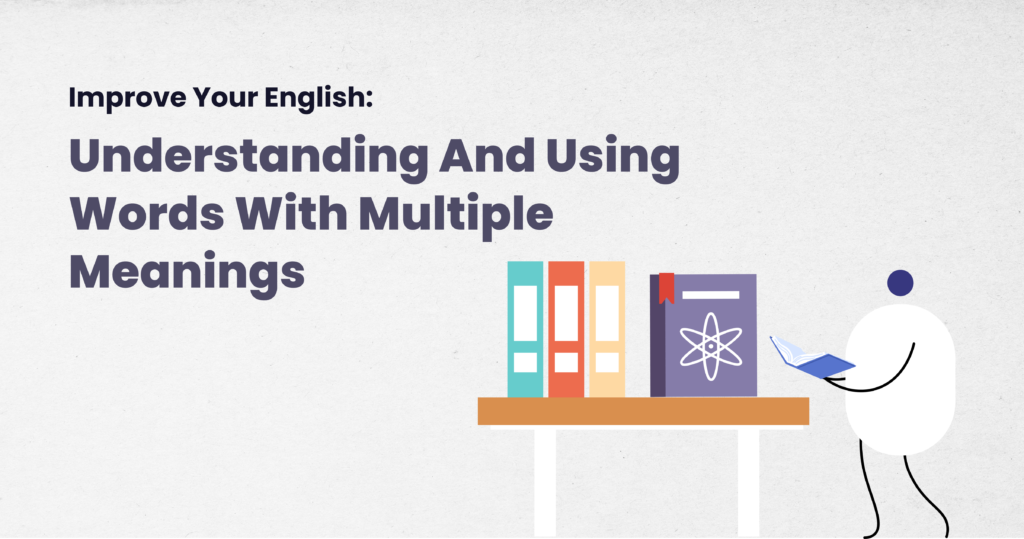One of the most fascinating aspects of the English language is its richness in words with multiple meanings. These words, often referred to as polysemes, can have different definitions depending on the context in which they are used. Understanding and using these words effectively is essential for anyone looking to speak better English. By mastering them, you can not only enrich your vocabulary but also enhance your ability to communicate clearly and precisely. Let’s explore how to understand and use words with multiple meanings with examples that will help you on your language-learning journey.
Why Words Have Multiple Meanings
English is a dynamic language that borrows words from various sources, and many words end up with multiple meanings over time. A word’s meaning can change depending on its usage in a sentence, and it can also be influenced by idiomatic expressions. By learning how to identify these nuances, you’ll be able to speak better English and avoid confusion in different situations.
Common Words with Multiple Meanings
Let’s dive into some examples of words with multiple meanings and how they can be used in different contexts:
1. “Bank”
- Financial Institution: “I need to go to the bank to deposit my paycheck.”
- Side of a River: “We had a picnic on the bank of the river.”
- A Place for Storing Things: “He went to the bank of memories, looking for inspiration.”
In this case, “bank” changes its meaning depending on whether you’re talking about money, nature, or memories.
2. “Bat”
- Flying Mammal: “I saw a bat flying near the cave.”
- Sporting Equipment: “He hit the ball with a bat during the game.”
- A Verb Meaning to Strike: “She batted the ball out of the park.”
The word “bat” is a great example of how one word can completely shift its meaning based on the context. Understanding such differences is key to improving your English.
3. “Light”
- Visible Light: “The room was filled with natural light from the window.”
- Not Heavy: “This bag is so light; I can carry it with one hand.”
- To Ignite: “He lighted the candles for the celebration.”
The word “light” can refer to brightness, weight, or the act of starting a fire, depending on how it’s used.
4. “Run”
- To Move Quickly: “I like to run in the park every morning.”
- To Manage or Operate: “She runs her own business.”
- A Sequence or Series: “The show had a successful run on television.”
As you can see, “run” can refer to physical activity, managing operations, or a period of time for events. The key is recognizing how the context shifts its meaning.
5. “Set”
- A Group of Things: “I bought a new set of dishes.”
- To Place or Put: “Please set the glass on the table.”
- A Sequence in Sports: “He won the first set in tennis.”
The word “set” is incredibly versatile and can mean a collection of objects, an action, or a part of a game.
Tips for Mastering Words with Multiple Meanings
- Pay Attention to Context The context in which a word is used often holds the key to its meaning. When you encounter a word with multiple meanings, try to understand the surrounding words or situation. This will help you decipher its intended meaning.
- Practice with Examples The more examples you encounter, the easier it will become to understand the different meanings of a word. Try creating your own sentences using words with multiple meanings to practice speaking and writing.
- Use Resources Online dictionaries, thesauruses, and language learning apps can help clarify the meanings of words with multiple definitions. Many of these tools provide example sentences to show how a word can be used in various contexts.
- Engage in Conversations The best way to learn how to use words with multiple meanings is through real conversations. Engage with native speakers, participate in language exchange programs, or practice with language learning apps. This will allow you to experience how different meanings are used in different situations, helping you speak better English.
- Learn Idiomatic Expressions Many words with multiple meanings are part of idiomatic expressions in English. These are phrases that don’t always make sense when translated directly but are used to convey particular meanings. For example, “bank on it” means to rely on something, and “run into someone” means to unexpectedly meet someone.
How to Speak Better English with Multiple Meaning Words
Learning how to speak better English involves understanding the nuances of words and their meanings. By recognizing the various meanings of words and using them correctly in different contexts, you will sound more fluent and confident. Additionally, mastering these words will expand your vocabulary, making your speech richer and more versatile.
The key is to practice regularly and expose yourself to different contexts where these words are used. The more you hear and see them in action, the easier it will be to understand and use them yourself.
Words with multiple meanings are a fascinating and important part of learning English. By mastering these words, you can improve your communication skills and speak better English. Remember to pay attention to context, practice with examples, and use resources to guide your learning. Over time, you’ll become more comfortable and confident using these versatile words in your conversations, enriching both your vocabulary and fluency.


